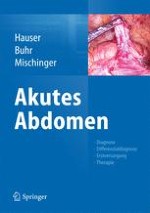2016 | OriginalPaper | Buchkapitel
39. Ösophagus
verfasst von : Prof. Dr. med. Prof. h.c. Dr. h.c. Jacob R. Izbicki, Dr. med. Bianca T. Hofmann, Priv.-Doz. Dr. med. Alexandra M. König, Dr. med. Stefan Groth, Prof. Dr. med. Thomas Rösch, Priv.-Doz. Dr. med. Asad Kutup
Erschienen in: Akutes Abdomen
Verlag: Springer Vienna











